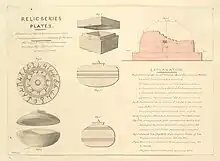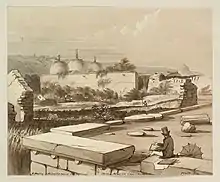Frederick Charles Maisey
Frederick Charles Maisey (1825–1892) was an English officer, archaeological surveyor and painter, active in India.[2][1] His main painting technique was pen and ink, and watercolour.[1] He was a lieutenant in the British Army circa 1850 in the Bengal Native Infantry, and participated to the British exploration of India.[2][3]
Masey was in charge of the excavation of Sanchi in 1851, working with fellow English officer Alexander Cunningham.[1] In 1852 he also made the earliest painting of the Temples at Khajuraho.[4]
Masey later became a British Army general on December 1, 1888.[2][5]
Maysey had a son, also named Frederick Charles Maisey, born on 7 July 1851, who became a lieutenant-colonel in the British Army.
Works
 5th century Bhima pillar, Eran. Watercolor by F.C. Maisey, 1850
5th century Bhima pillar, Eran. Watercolor by F.C. Maisey, 1850
 Relics discovered in the excavation of Sanchi Stupa No.2
Relics discovered in the excavation of Sanchi Stupa No.2
See also
References
- Wright, Colin. "'Miscellaneous Series. Plate.12. Juma Masjid, Chanderi'. Maisey in a top-hat sketching in the foreground". www.bl.uk.
- Hoock, Holger (2010). Empires of the Imagination: Politics, War and the Arts in the British World, 1750-1850. Profile Books. p. 344. ISBN 978-1-86197-859-2.
- Singh, Sohini (June 2018). "Occidental Encounters and Impressions: The Trajectory of British-instituted Practices of Survey and Documentation in India with Special Reference to Frederick Charles Maisey's Drawings of Chanderi". Indian Historical Review. 45 (1): 58–91. doi:10.1177/0376983617750663. S2CID 149662516.
- Punja, Shobita (2010). Khajuraho: The First Thousand Years. Penguin UK. p. 17. ISBN 978-93-85890-40-6.
- London Gazette. 1888. p. 7203.
Wikimedia Commons has media related to Frederick Charles Maisey.
This article is issued from Wikipedia. The text is licensed under Creative Commons - Attribution - Sharealike. Additional terms may apply for the media files.
